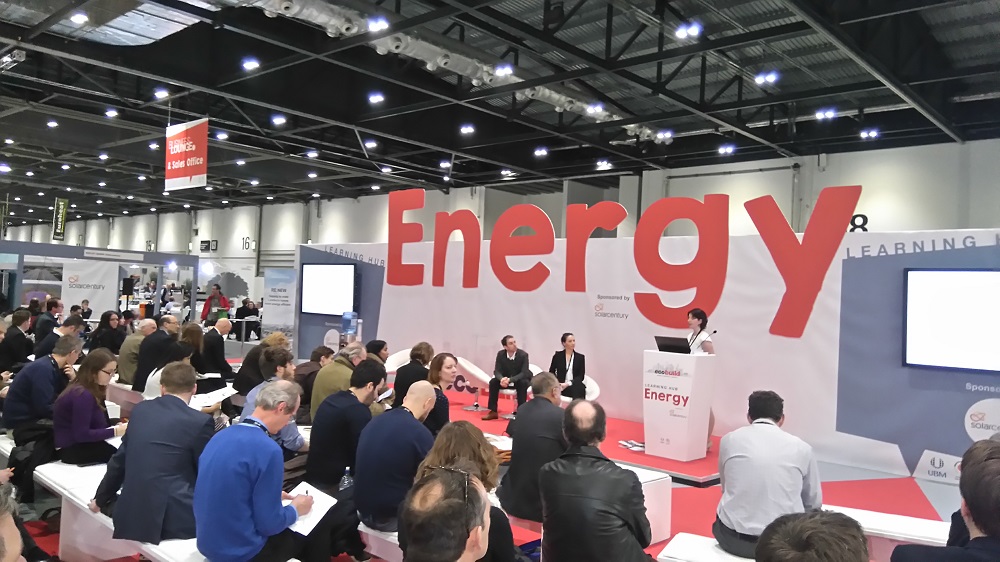Ecobuild 2016 - Making the business case for large scale retrofit investment
Designing Buildings Wiki went to the Excel Centre for day one of EcoBuild 2016, the UK’s largest construction and energy event.
The rationale for domestic retrofit is as important as ever. Retrofit not only cuts carbon emissions, it makes it cheaper to keep homes warm and helps to overcome poor ventilation and damp, and improves health. The seminar, chaired by Kore Mason, programme manager for the Greater London Authority, explored the business case for energy efficiency works as well as how to identify and manage the technical risks.
George Simm, energy consultant at Capita, began by asking why exactly retrofit needs a business case? The main reasons, he said, where to show clearly how benefits can be maintained, ensure projects are deliverable, gain senior level buy-in, and help plan future phases.
According to Simm, in a time of unprecedented business pressures, every funding plan for housing developers needs to be justified, and that retrofit is still seen as being a ‘nice to have’ rather than a necessity. It is vital that the wider benefits are demonstrated, such as the generation of local employment and the increase in Net Present Value of the project that often results.
Making a strong case requires:
- Good understanding of drivers and targets.
- Ability to articulate the full range of benefits beyond tenant welfare.
- Sound plan for funding, procurement and delivery.
Simm said funding is still available from a range of sources, but projects that can demonstrate a return have the best chance of success. He was confident that organisations willing to develop the case for retrofit would see benefits in the future, and cited the Energiesprong organisation currently aimed at social housing providers as an example.
Lisa Pasquale, director of Six Cylinder, spoke about managing the risks of retrofit. She cited the most common problems as: underventilation and condensation, air leakage, mould issues, interstitial condensation, and overheating. Not to mention the negative impact on profit and reputation for housing associations having to deal with remedial works.
She said that to mitigate the risks, it was important to understand the retrofit process, and modify and strengthen it according to each individual project.
On the question of why retrofit can go wrong, Pasquale made the following diagnoses:
- Overambitious performance gains claimed by designers and suppliers.
- A lack of robustness of detailed design.
- Fragmented procurement and delivery (lack of overall responsibility and ownership).
- Poor construction sequencing and commissioning.
- Inadequate handover and user guidance.
She suggested that between each of the four retrofit processes – assessment, design, installation, operation – there needed to be ‘retrofit watch points’ to help alleviate problems due to poor integration between trades, such as inappropriate substitutions to materials and products.
On the issue of post-occupancy evaluation, she stressed the need for monitoring fuel use, occupant surveys, air permeability testing and thermographic surveys. She also said it was important to take account of the fact that residents may have been underheating their property prior to retrofitting due to fuel poverty.
While the green building industry may have suffered substantial setbacks at the hands of the Conservative government, there are still signs that progress is being made. Although some members of the audience expressed concerns that it was too little and too slow, the speakers seemed confident that the business model for retrofit will become more coordinated as bigger firms start to get involved, working with smaller ones and increasing numbers of projects.
[edit] Find out more
[edit] Related articles on Designing Buildings Wiki
- Allowable solutions for zero carbon buildings.
- BRE and Willmott Dixon project to retrofit of a 1920s semi-detached house.
- Building Places that Work for Everyone.
- Ecobuild 2016 - What makes good housing?
- Ecobuild 2016 - What makes housing fit for the future?
- Ecobuild 2017.
- Green building.
- Home Quality Mark.
- How to deal with retrofit risks.
- Leadership in Energy and Environmental Design LEED.
- National Refurbishment Centre.
- Nearly zero energy buildings.
- Retrofit.
- Retrofit coordinator.
- The Each Home Counts report and traditional buildings.
- Zero Bills Home.
- Zero carbon homes.
IHBC NewsBlog
Images from inside a Grade II listed hotel show the scale of its collapse
The Corbett Arms in Tywyn has fallen into serious disrepair.
Old Sarum fire in listed (& disputed) WW1 Hangar - Wiltshire Council has sought legal advice after fire engulfed a listed First World War hangar that was embroiled in a lengthy planning dispute.
UK Antarctic Heritage Trust launches ‘Virtual Visit’ website area
The Trust calls on people to 'Immerse yourself in our heritage – Making Antarctica Accessible'
Southend Council pledge to force Kursaal owners to maintain building
The Council has pledged to use ‘every tool in the toolbox’ if urgent repairs are not carried out.
HE’s Research Magazine publishes a major study of the heritage of England’s suburbs
The article traces the long evolution of an internal programme to research 200 years of suburban growth
IHBC Context 183 Wellbeing and Heritage published
The issue explores issues at the intersection of heritage and wellbeing.
SAVE celebrates 50 years of campaigning 1975-2025
SAVE Britain’s Heritage has announced events across the country to celebrate bringing new life to remarkable buildings.
IHBC Annual School 2025 - Shrewsbury 12-14 June
Themed Heritage in Context – Value: Plan: Change, join in-person or online.
200th Anniversary Celebration of the Modern Railway Planned
The Stockton & Darlington Railway opened on September 27, 1825.
Competence Framework Launched for Sustainability in the Built Environment
The Construction Industry Council (CIC) and the Edge have jointly published the framework.














